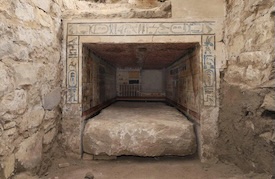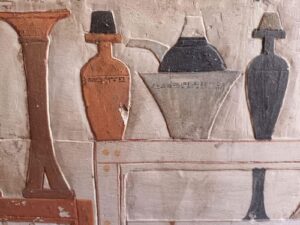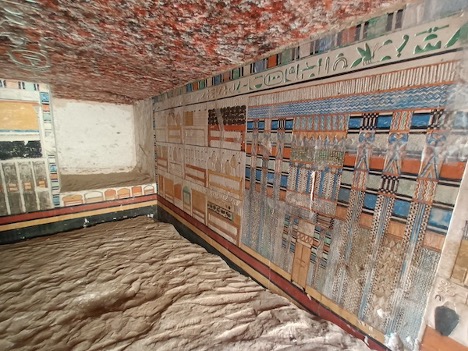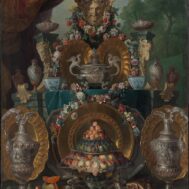
Tomb wall detail showing offerings, Credit: Franco-Swiss Archaeological Mission of Saqqara.
Archaeologists in Egypt have uncovered a masterfully decorated tomb belonging to a royal physician who served the pharaohs over 4,000 years ago. Discovered in the vast necropolis of Saqqara, the tomb belonged to Teti Neb Fu, a prestigious healer who lived during Egypt’s Old Kingdom, under the reign of King Pepi II around the 23rd century B.C.E. Teti Neb Fu’s mastaba lies near the funerary complex of King Pepi I and is part of an excavation focused on the Sixth Dynasty, sometimes considered the last dynasty of Old Kingdom Egypt.
The find was made by the Franco-Swiss Archaeological Mission of Saqqara, co-directed by Dr. Philippe Collombert, Professor of Egyptology at the University of Geneva, and Xavier Hénaff, archaeologist at Inrap (France’s National Institute for Preventive Archaeological Research).[1] The French Archaeological Mission of Saqqara has worked in Egypt since 1963.

Exterior view of the excavated tomb. Credit: Franco-Swiss Archaeological Mission of Saqqara.
The Sixth Dynasty kings ruled from Memphis, and Saqqara is the site of their pyramids and the tombs of many courtier and court functionaries. While excavating a seemingly ordinary kiln-type tomb in front of the mastaba of Vizier Ouni, the team stumbled upon what initially appeared to be a modest burial. These mudbrick tombs, common in the necropolis of Pepy I, were often looted in ancient times, and little remains. This tomb was different.
As excavation began, the team unearthed a beautifully preserved false door stele inscribed with the name Tetinebefou—a doctor. Soon after, they uncovered a limestone lintel above the shaft to the burial chamber, also carved with his name and elaborate titles. As they descended further, an astonishing sight emerged. As Dr. Collombert described it,
“…we weren’t at the end of our surprises! As we progressed in clearing the shaft, we saw the walls of the burial chamber appear, entirely decorated with paintings in bright, fresh colors! It’s easy to forget they’re 4,000 years old! Of the funerary material, only tiny fragments remained, left by the looters, but the tomb’s decorations were enough to make the discovery so exceptional that it was officially announced by the Ministry of Antiquities.”

Tomb wall detail showing vessels and offerings, Credit: Franco-Swiss Archaeological Mission of Saqqara.
The stone sarcophagus within the tomb listed an impressive array of titles in hieroglyphics: Chief Palace Physician, Priest and Magician of the Goddess Serket, Chief Dentist, and Director of Medicinal Plants. These titles suggest that the tomb’s occupant, Teti Neb Fu, was not just a healer, but also a master of spiritual protection. His association with Serket, goddess of venom and healing, points to specialization in treating scorpion and snake bites—life-threatening ailments in desert Egypt.
[1] The French Archaeological Mission of Saqqara is one of the longest operating archaeological services in Egypt, having been founded in 1963 by Jean Leclant of the Sorbonne, with the Jean-Philippe Lauer, architect and Egyptologist with the Egyptian Antiquities Service. The mission works at the Saqqara site every winter. Among its many excavation sites are the necropolis of Pepy I at the pyramids of Kings Pepy II and Ibi, as well as the funerary complex of Queen Neit. https://www.unige.ch/mafssaqqara/blog/post-2024-5
 The mastaba tomb of Teti Neb Fu, with intricate carvings and brilliantly preserved paintings. Credit: Franco-Swiss Archaeological Mission of Saqqara.
The mastaba tomb of Teti Neb Fu, with intricate carvings and brilliantly preserved paintings. Credit: Franco-Swiss Archaeological Mission of Saqqara. 

